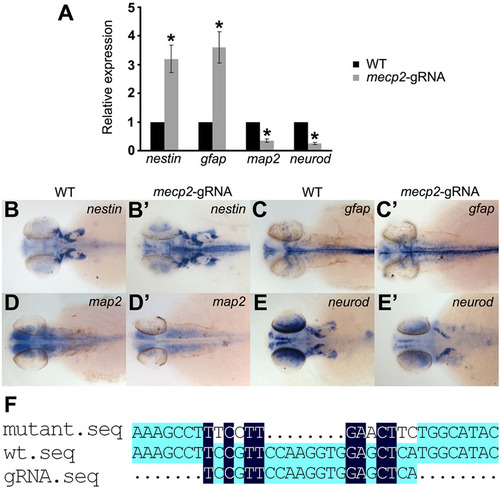
mecp2 regulates neural cell differentiation by down-regulating id1 expression. (A) The number of proliferative cells labeled by Tg(ef1α:mAG-zGem) increased in mecp2 morphants, and this was rescued either by co-injection of id1-MO or mecp2 mRNA at 48hpf. Proliferative cell number increased in embryos injected with id1 mRNA to a level similar to that in mecp2 morphants. Moreover, embryos injected with id1-MO or mecp2 mRNA had fewer proliferative cells than wild-type controls at 48hpf. Note that mecp2 normally suppresses id1 to regulate neural cell proliferation. Error bars indicate the s.d. Statistics of all the groups were calculated by comparison with the wild-type (WT) group. *P<0.05; ns, not significant. (B–D′′) In Tg(neurod:EGFP) transgenic embryos, neurod decreased in mecp2 morphants (B′) and this was rescued by co-injection with id1-MO at 48hpf (B′′), compared with controls (B). Immunostaining revealed that Huc was reduced in mecp2 morphants (C′) and this was rescued by co-injection with id1-MO (C′′), compared with controls (C). In Tg(islet1:EGFP) transgenic embryos, the motor neurons were eliminated in mecp2 morphants (D′), and this was rescued by co-injection with id1-MO (D′′), compared with wild-type controls (D). Dorsal views with anterior to the left (B-D′′); numbers in the bottom right corner represent the number of embryos showing the indicated phenotype/total embryos examined. (E) Summary cartoon of the control of neural cell differentiation by Mecp2 in zebrafish. MeCP2 negatively fine-tunes the expression levels of id1, which leads to activation of her2, which normally promotes the formation of astrocytes while inhibiting the derivation of neurons from neural precursors.
|

